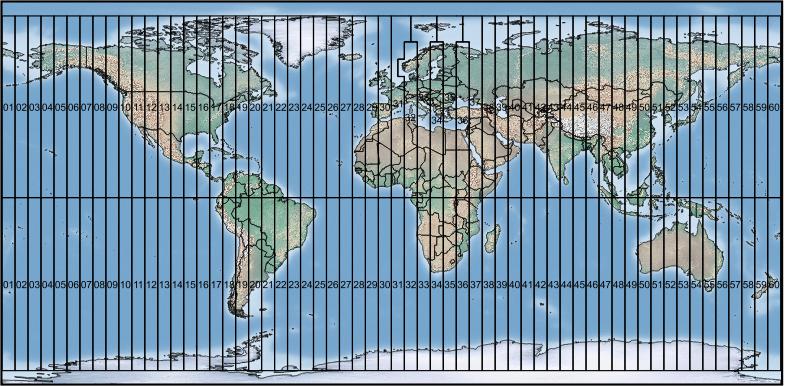

text ( x, y, ' %d ' % zone, horizontalalignment = 'center', verticalalignment = 'center', size = 26, weight = 'bold' ) pylab. drawmeridians ( range ( - 126, 67, 6 ), linewidth = 2, dashes =, labels =, size = 12 ) for zone in range ( 10, 20 ): x, y = bm ( - 180 + 6 * zone - 3, 40 ) pylab. drawstates ( linewidth = 0.5, color = '0.6' ) # Draw Meridians and Label UTM Zones bm. drawcountries ( linewidth = 1.0, color = '0.3' ) bm. use ( 'GTKCairo' ) import pylab # Setup figure, axes, and map projection fig = pylab. User input: +proj=utm +zone=19 +ellps=GRS80 +datum=NAD83ĮLLIPSOID["GRS 1980",6378137,298.#!/usr/bin/env python # -*- coding: utf-8 -*- from mpl_toolkits.basemap import Basemap import matplotlib matplotlib. To extract CS information from a raster object use the crs function from the raster package.
Utm zones usa code#
The CRS output will also consist of a user defined CS definition which can be an EPSG code (as is the case in this example), or a string defining the datum and projection type. The WKT format will usually start with a PROJCRS tag for a projected coordinate system, or a GEOGCRS tag for a geographic coordinate system.
Utm zones usa series#
With the newer version of the PROJ C library, the coordinate system is defined using the Well Known Text ( WTK/ WTK2) format which consists of a series of tags. PARAMETER["Scale factor at natural origin",0.9996, PARAMETER["Longitude of natural origin",-69, PARAMETER["Latitude of natural origin",0, Generate the variance and confidence interval maps.Moran’s I as a function of a distance band.Computing the Moran’s I statistic: the easy way.Computing a pseudo p-value from an MC simulation.Computing the Moran’s I statistic: the hard way.Test for a poisson point process model with a covariate effect.Computing a pseudo p-value from the simulation.Modeling intensity as a function of a covariate.Quadrat density on a tessellated surface.Getting external data into a spatstat format.Understanding the Proj4 coordinate syntax Universal Transverse Mercator (UTM) is a 1,000 meter by 1,000 meter square, coordi- nate system, and is measured from the Equator.A note about the changes to the PROJ environment.Binary operations and functions (where two rasters are used).Unary operations and functions (applied to single rasters).Local Empirical Bayes (EB) rate estimate.

Global Empirical Bayes (EB) rate estimate.Standardized mortality ratios (relative risk).Clipping spatial objects using other spatial objects.MULTIPOLYGON simple feature: multipart features.Purpose: To provide users with an UTM zone service. If a UTM Zone split a county, the dominant zone was chosen as the official zone for NRCS purposes. Counties were assigned to their UTM Zone. Adding a geometry column to an existing non-spatial dataframe Counties by UTM Zone Designations (0) UTM Zone (1) Description: This data set portrays the UTM zones of United States and its territories.Step 3: Create the simple feature object sf.Step 2: Create a column of simple feature geometries: sfc.Splitting data by polygons or group of polygons.Exporting to different data file formats.Converting a raster object to an im object ( spatstat).Converting an sf point object to a ppp object.Converting an sf polygon object to an owin object.Converting an sf object to a Spatial* object ( spdep/ sp).Creating a spatial object from a data frame.A Reading and writing spatial data in R.14.2 Statistical Approach to Interpolation.14.1.3 Fine tuning the interpolation parameters.14.1 Deterministic Approach to Interpolation.13.1.2 Monte Carlo approach to estimating significance.12.4 Monte Carlo test with K and L functions.12.2.2 A better approach: a Monte Carlo test.12.2.1 ArcGIS’ Average Nearest Neighbor Tool.11.3.3 The Pair Correlation Function \(g\).11.2.3 Modeling intensity as a function of a covariate.10.5.1 Mathematical operators and functions.9.1.4 Building the Geographic Coordinate System.8 Spatial Operations and Vector Overlays.7.5 Problem when performing bivariate analysis.4.4 So how do I find a proper color scheme for my data?.


 0 kommentar(er)
0 kommentar(er)
